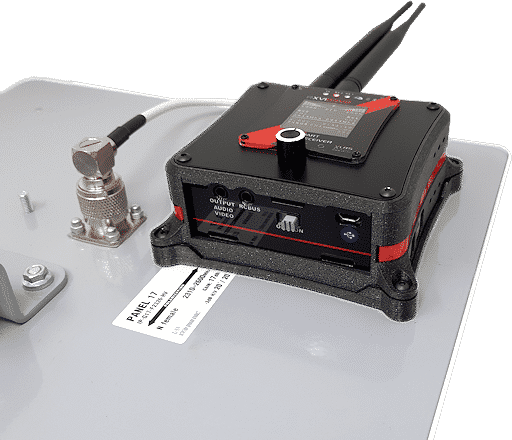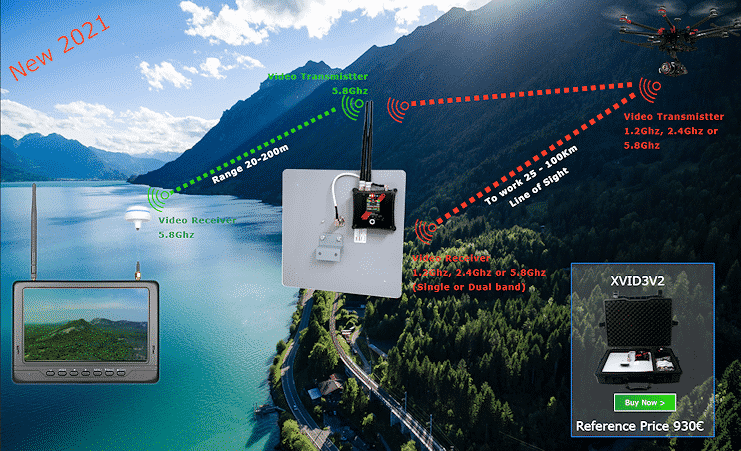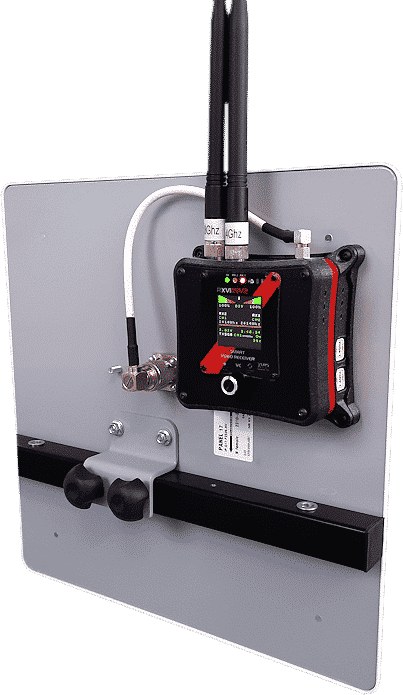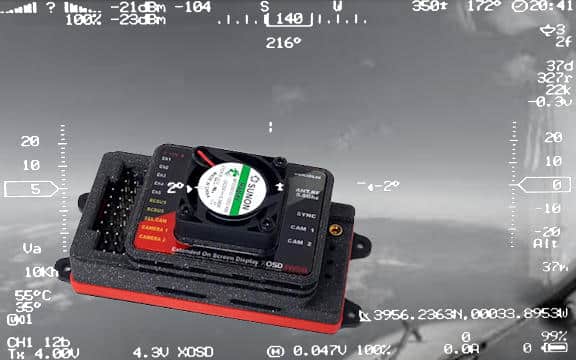Choice of frequency band with analog video system:
These are the novelties of RXVID3V2 from the point of view of the frequency bands. The RXVID3V2 analog video receiver internally has two video receivers to work in diversity mode. Now each receiver can be tuned independently of different channels, this serves for redundant video systems selecting the best video available or to manually switch two XOSD or different video transmitters for special cases.
Normally, the two receivers tune to the same channel. In the new version, each receiver can also be in a different frequency band. As an example, receiver 1 can be in 2.4Ghz and receiver 2 in 5.8Ghz. When ordering you can choose the frequency band of each of the receiver modules.
Redundant Video:
In principle, it is normal to use the same frequency band, but if we decide to have redundant video, two XOSDs can be used in the drone or plane in two different bands simultaneously and the RXVID3V2 receive the best signal of both in different bands, which increases security at the reception.
3 frequency bands:
XVID3 is available in three frequency bands: 1.2Ghz, 2.4Ghz and 5.8Ghz.
There are no good bands and others bad, it depends on several factors in each specific case.
Each frequency band has its advantages and disadvantages, we will list some from different points of view to increase your understanding and facilitate the choice of the band.
Normative:
The first thing is to check the regulations in force in the country of use, this will already give us an idea that what frequency band can or cannot be used and the maximum power to use.
If the power of the XOSD is higher than allowed and you need to lower it, you can add a 2W SMA attenuator at the antenna output of the necessary value.
Interference:
We must never interfere with other communications and, of course, we must avoid as much as possible that they interfere with us, so we must choose the freest band and channels possible in the place of use.
1.2Ghz:
The 1.2Ghz band on the CH4 at 1200Mhz, can interfere with military GPS channels. The CH1 channel at 1080Mhz can interfere with the ASDB (secondary aviation radar) which is very close at 1090Mhz. These two channels should not be used.
In CH6 about 1300Mhz and depending on the country it can be used by amateur video and there is also usually a channel reserved for the military.
2.4Ghz:
The 2.4Ghz free band is full of communications: wifi, bluetooth, RC stations, etc. Especially in the city, so it is not a good idea to use video in this frequency band in the city or near the city, it is possible that they do not interfere with us but surely we will interfere with others. If you are going to use 2 to several km from a major city or town, the problem is mitigated or almost non-existent.
You may experience video interference near a model airfield as radio amateurs use 2.4Ghz. It is enough to go a few hundred meters or use the channels outside the standard band (CH5 to CH8) if local regulations allow or have permission.
5.8Ghz:
This band is somewhat freer than the 2.4Ghz band, but wifi systems are already available in the 5.8Ghz band, which means that in cities it is possible to interfere or be interfered, outside the city it is likely that you will not have interference.
If there are drones or FPV systems nearby, some channels may interfere, check before using that your channel is not in use and if it is, change it to a free one.
Video Channels and Frequencies:
1.2Ghz:
CH1 1080Mhz Do not use by proximity with ADSB at 1090Mhz
CH2 1120Mhz
CH3 1160Mhz
CH4 1200Mhz Do not use for close use military GPS band
CH5 1280Mhz
CH6 1320Mhz
CH7 1360Mhz
2.4Ghz:
CH1 2414Mhz
CH2 2432Mhz
CH3 2450Mhz
CH4 2468Mhz
CH5 2490Mhz Out of standard band.
CH6 2519Mhz Out of standard band.
CH7 2390Mhz Out of standard band.
CH8 2370Mhz Out of standard band.
CH1 5705Mhz
CH2 5685Mhz
CH3 5665Mhz
CH4 5645Mhz
CH5 5885Mhz
CH6 5905Mhz
CH7 5925Mhz
Resolution:
All three systems use Video PAL with 625 lines.
1.2Ghz It is the band with a little less definition.
2.4Ghz is the average between 1.2 and 5.8Ghz.
5.8Ghz will be seen with more purity.
Video receiver and antennas:
Remember that the receiver is diversity (double receiver, automatically selecting the best reception of the two). By default it comes with a high gain directional antenna (10 to + 23dBi depending on the RF band) and an omnidirectional antenna with equal average gain for the 3 bands: 5dBi.
The directional antenna serves to achieve the greatest possible range on distant flights.
The omnidirectional antenna is used to fly close where it will no longer be necessary to point the directional antenna.
The receivers have very similar characteristics in the three frequency bands, all three have a small 5.8Ghz emitter-repeater to be able to watch the video away from the antennas without the need for cables.
Directional antennas have different gain, so it is possible to equalize the size in the three bands as much as possible and compensate the attenuation of the higher frequencies with antennas of higher gain, balancing as much as possible the range in the three frequency bands.
Balanced range in kits:
The kits have been balanced in comparative range characteristics, as far as possible, compensating the shorter range of the higher frequency with higher gain antennas, so the range with the directional antennas will be similar in all 3 cases with the particularities of the different frequencies.
Video link and range:
Comparatively the 5.8Ghz video link is about 2.5 times more critical than 2.4Ghz and this in turn is about 2 times more critical than 1.2Ghz.
This with the 5dbi omnidirectional antennas in all cases it is noted that 1.2Ghz would reach the directional antennas without pointing, about 2 times more than 2.4Ghz and about 5 times more than 5.8Ghz.
1.2Ghz: the lower frequency, is the one with the greatest range, it crosses obstacles better and has less sharpness. With antennas of the same gain we will have practically twice the range of 2.4Ghz in practice. In exchange, the antennas are twice as large. In the kit, the antennas supplied for the receiver are a 9-10dBi biquad and a 5dbi omnidirectional. The biquad antenna will achieve an approximate range of 40Km and low directionality with an angle tolerance to point almost twice that of the 2.4Ghz system, which will make video reception easier.
With the omnidirectional antenna it will have a radius of action without aiming twice that of 2.4Ghz, in practice about 4 to 6Km or more.
2.4Ghz: It is the intermediate frequency band, combines more sharpness, somewhat crosses obstacles such as trees and houses, has greater directionality than 1.2Ghz, therefore somewhat more critical to aim with the directional antenna. The kit has a directional patch of 17dBi that will offer an approximate range of 35Km and an omnidirectional of 5dBi that will allow you to reach a radius without aiming of about 2Km or something more depending on cases.
5.8Ghz: The highest frequency band. With sharper focus, shorter range and more critical directionality, obstacles such as trees or houses can cancel the reception of the video. The kit has a 23dBi directional patch and a 5dbi omnidirectional patch. The aiming range will be around 1 to 1.5Km. With the directional it can reach about 25 to 30km. The most economical and portable option if you use an FPV monitor with a 5.8Ghz video receiver (with or without an XPAD transmitter) and an XOSD3B on the drone, plane, robot, etc.
Summary:
1.2Ghz: Select a team in this band only when essential.
2.4Ghz: Use this band if you want a good combination of range, sharpness and directionality, as long as the use is out of town since the band is saturated.
5.8Ghz: It has greater clarity, if the range is not a problem and if you use only an XOSD3B and an FPV monitor or video glasses at 5.8Ghz, it is the most economical option.













